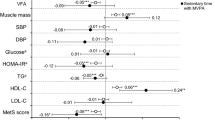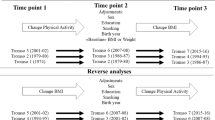Abstract
Objectives:
High levels of physical activity (PA) may prevent the development of obesity. However, the magnitude and direction of the association between PA of various intensities, sedentary time and weight status remain unclear. Thus, we examined whether objectively measured sedentary time and PA independently predict gain in body weight, change in body weight and to examine the possibility of reverse causation.
Methods:
We examined the prospective associations between sedentary time, PA and body weight (BW). Baseline measurements were conducted in 2008/2009 and follow-up measurements in 2014/2015 in a random sample of the adult Norwegian population (N=1710, 45.1% men). Moderate and vigorous intensity PA (MVPA) and sedentary time were measured by accelerometry and BW and height self-reported. We first modelled the associations between baseline sedentary time and PA with BW at follow-up. We then modelled the reverse associations (BW as the exposure) and sedentary time and PA (as outcomes) in separate models. All models were adjusted for age, sex, baseline value of the outcome, socio-economic status, alcohol consumption, smoking, monitor wear time and follow-up time.
Results:
Body mass index (BMI) increased by 0.2 units (P=0.003) between baseline and follow-up, and 46.5% of participants were either overweight (36.4%) or obese (10.1%) at baseline increasing to 49.6% (11.7% obese) at follow-up. Baseline sedentary time, MVPA and vigorous PA were not associated with BW at follow-up after adjustment for covariates. In contrast, baseline BW was inversely associated with MVPA (β=−0.11; 95% confidence interval (CI); −0.21, −0.009) and VPA (β=−0.035; 95% CI; −0.059, −0.011) in adjusted models. These associations were unchanged when BW was substituted by BMI.
Conclusions:
Baseline BW seems to determine a decrease in MVPA in healthy adult Norwegian men and women, more so than the reverse.
This is a preview of subscription content, access via your institution
Access options
Subscribe to this journal
Receive 12 print issues and online access
$259.00 per year
only $21.58 per issue
Buy this article
- Purchase on Springer Link
- Instant access to full article PDF
Prices may be subject to local taxes which are calculated during checkout

Similar content being viewed by others
References
Ng M, Fleming T, Robinson M, Thomson B, Graetz N, Margono C et al. Global, regional, and national prevalence of overweight and obesity in children and adults during 1980-2013: a systematic analysis for the Global Burden of Disease Study 2013. Lancet 2014; 384: 766–781.
WHO Global Health Observatory Data Repository. Geneva, World Health Organization, 2013http://apps.who.int/gho/data/view.main (accessed 20 January 2017).
The Global Burden of Metabolic Risk Factors for Chronic Diseases Collaboration (BMI Mediated Effects). Metabolic mediators of the effects of body-mass index, overweight, and obesity on coronary heart disease and stroke: a pooled analysis of 97 prospective cohorts with 1.8 million participants. Lancet 2014; 383: 970–983.
Berrington de Gonzalez A, Hartge P, Cerhan JR, Flint AJ, Hannan L, MacInnis RJ et al. Body-mass index and mortality among 1.46 million white adults. N Engl J Med 2010; 363: 2211–2219.
Hutfless S, Gudzune KA, Maruthur N, Wilson RF, Bleich SN, Lau BD et al. Strategies to prevent weight gain in adults: a systematic review. Am J Prev Med 2013; 45: e41–e51.
Wareham NJ, van Sluijs E, Ekelund U . Physical activity and obesity prevention: a review of the current evidence. Proc Nutr Soc 2005; 64: 229–247.
Wilks D, Besson H, Lindroos A, Ekelund U . Objectively measured physical activity and obesity prevention in children, adolescents and adults: a systematic review of prospective studies. Obes Rev 2011; 12: e119–e129.
Ekelund U, Besson H, Luan J, May AM, Sharp SJ, Brage S et al. Physical activity and gain in abdominal adiposity and body weight: Prospective cohort study in 288,498 men and women. Am J Clin Nutr 2011; 93: 826–835.
Hankinson AL, Daviglus ML, Bouchard C, Carnethon M, Lewis CE, Schreiner PJ et al. Maintaining a high physical activity level over 20 years and weight gain. JAMA 2010; 304: 2603–2610.
Wareham NJ, Brage S . Commentary: physical activity and obesity; scientific uncertainty and the art of public health messaging. Int J Epidemiol 2014; 42: 1843–1845.
Same RV, Feldman DI, Shah N, Martin SS, Al Rifai M, Blaha MJ et al. Relationship between sedentary behavior and cardiovascular risk. Curr Cardiol Rep 2016; 18: 6.
Ekelund U, Johannessen JS, Brown W, Fagerland M, Owen N, Powell K et al. Does physical activity attenuate, or even eliminate the detrimental association between sitting time and all-cause mortality? A harmonised meta-analysis on data in more than one million men and women. Lancet 2016; 388: 1302–1310.
Van Dyck D, Cerin E, De Bourdeaudhuij I, Hinckson E, Reis RS, Davey R et al. International study of objectively measured physical activity and sedentary time with body mass index and obesity: IPEN adult study. Int J Obes 2015; 39: 199–207.
Ekelund U, Brage S, Besson H, Sharp S, Wareham NJ . Sedentary time and weight gain in healthy adults; reverse or bidirectional causality? Am J Clin Nutr 2008; 88: 612–617.
Helmerhorst HJF, Brage S, Warren J, Besson H, Ekelund U . A systematic review of reliability and objective criterion-related validity of physical activity questionnaires. Int J Behav Nutr Phys Act 2012; 9: e103.
Hansen BH, Kolle E, Dyrstad SM, Holme I, Anderssen SA . Accelerometer-determined physical activity in adults and older people. Med Sci Sports Exerc 2012; 44: 266–272.
Sasaki JE, John D, Freedson PS . Validation and comparison of ActiGraph activity monitors. J Sci Med Sport 2011; 14: 411–416.
Kaminsky LA, Ozemek C . A comparison of the Actigraph GT1M and GT3X accelerometers under standardized and free-living conditions. Physiol Meas 2012; 33: 1869–1876.
Trost SG, McIver KL, Pate RR . Conducting accelerometer-based activity assessments in field-based research. Med Sci Sports Exerc 2005; 37 (11 suppl): S531–S543.
Matthews CE, Chen KY, Freedson PS, Buchowski MS, Bleech BM, Pate RR et al. Amount of time spent in sedentary behaviors in the United States, 2003–2004. Am J Epidemiol 2008; 167: 875–881.
Troiano RP, Berrigan D, Dodd KW, Masse LC, Tilert T, McDowell M . Physical activity in the United States measured by accelerometer. Med Sci Sports Exerc 2008; 40: 181–188.
Matthews CE . Calibration of accelerometer output for adults. Med Sci Sports Exerc 2005; 37 (11 suppl): S512–S522.
World Health Organization. BMI classificationhttp://apps.who.int/bmi/index.jsp?introPage=intro_3.html(accessed 8 February 2017).
Lee IM, Djoussé L, Sesso HD, Wang L, Buring JE . Physical activity and weight gain prevention. JAMA 2010; 303: 1173–1179.
Dugas LR, Kliethermes S, Plange-Rhule J, Tong L, Bovet P, Forrester TE et al. Accelerometer-measured physical activity is not associated with 2-year weight change in African-origin adults from 5 diverse populations. Peer J 2017; 5: e2902.
Golubic R, Ekelund U, Wijndaele K, Luben R, Khaw KT, Wareham NJ et al. Rate of weight gain predicts change in physical activity levels: a longitudinal analysis of the EPIC-Norfolk cohort. Int J Obes 2013; 37: 404–409.
Golubic R, Wijndaele K, Sharp S, Simmons R, Griffin S, Wareham NJ et al. Physical activity, sedentary time and gain in overall and central body fat: seven year follow-up of the ProActive trial cohort. Int J Obes 2015; 39: 142–148.
Richmond RC, Davey Smith G, Ness AR, den Hoed M, McMahon G, Timpson NJ . Assessing causality in the association between child adiposity and physical activity levels: a Mendelian randomization analysis. PLoS Med 2014; 11: e1001618.
Friend DM, Devarakondra K, O'Neal TJ, Skirzewski M, Papazogolu I, Kaplan AR et al. Basal ganglia dysfunction contributes to physical inactivity in obesity. Cell Metab 2017; 25: 1–10.
Levine JA, McCrady SK, Lanningham-Foster LM, Kane PH, Foster RC, Manohar CU . The role of free-living daily walking in human weight gain and obesity. Diabetes 2008; 57: 548–554.
van Uffelen JG, Watson MJ, Dobson AJ, Brown WJ . Sitting time is associated with weight, but not with weight gain in mid-aged Australian women. Obesity 2010; 18: 1788–1794.
Pulsford RM, Stamatakis E, Britton AR, Brunner EJ, Hillsdon MM . Sitting behaviour and obesity: evidence from the Whitehall II study. Am J Prev Med 2013; 44: 132–138.
Pedisic Z, Grunseit A, Ding D, Chau JY, Banks E, Stamatakis W et al. High sitting time and obesity: Which came first? Bidirectional association in a longitudinal study of 31,787 Australian adults. Obesity 2014; 22: 2126–2130.
Lee IM, Shiroma EJ, Lobelo F, Puska P, Blair SN, Katzmarzyk PT . Effect of physical inactivity on major non-communicable diseases worldwide: an analysis of burden of disease and life expectancy. Lancet 2012; 380: 219–229.
Pedersen BK, Saltin B . Exercise as medicine – evidence for prescribing exercise as therapy in 26 different chronic conditions. Scand J Med Sci Sports 2015; 25 (Suppl: 3): 1–72.
Hopkins M, Blundell JE . Energy balance, body composition, sedentariness and appetite regulation: pathways to obesity. Clin Sci 2016; 130: 1615–1628.
Spencer EA, Appleby PN, Davey GK, Key TJ . Validity of self-reported height and weight in 4808 EPIC-Oxford participants. Public Health Nutr 2002; 5: 561–565.
Hansen BH, Holme I, Anderssen SA, Kolle E . Patterns of objectively measured physical activity in normal weight, overweight, and obese individuals (20-85 years): a cross-sectional study. PLoS One 2013; 8: e53044.
Acknowledgements
We are grateful to all the participants who devoted their time to participate in the study. We would also like to express our sincere gratitude to all those who contributed to recruitment, data collection and other administrative duties associated with the study. Finally, we are extremely grateful to Inge Dehli Andersen who set up and managed the database. This work was supported by the Norwegian Directorate of Health.
Author information
Authors and Affiliations
Corresponding author
Ethics declarations
Competing interests
The authors declare no conflict of interest.
Additional information
Supplementary Information accompanies this paper on International Journal of Obesity website
Supplementary information
Rights and permissions
About this article
Cite this article
Ekelund, U., Kolle, E., Steene-Johannessen, J. et al. Objectively measured sedentary time and physical activity and associations with body weight gain: does body weight determine a decline in moderate and vigorous intensity physical activity?. Int J Obes 41, 1769–1774 (2017). https://doi.org/10.1038/ijo.2017.186
Received:
Revised:
Accepted:
Published:
Issue Date:
DOI: https://doi.org/10.1038/ijo.2017.186
This article is cited by
-
Genetic susceptibility, screen-based sedentary activities and incidence of coronary heart disease
BMC Medicine (2022)
-
How COVID-19 lockdown and reopening affected daily steps: evidence based on 164,630 person-days of prospectively collected data from Shanghai, China
International Journal of Behavioral Nutrition and Physical Activity (2021)
-
High-intensity activity is more strongly associated with metabolic health in children compared to sedentary time: a cross-sectional study of the I.Family cohort
International Journal of Behavioral Nutrition and Physical Activity (2021)
-
Physical activity and 4-year changes in body weight in 52,498 non-obese people: the Lifelines cohort
International Journal of Behavioral Nutrition and Physical Activity (2021)
-
The bidirectional associations between leisure time physical activity change and body mass index gain. The Tromsø Study 1974–2016
International Journal of Obesity (2021)



